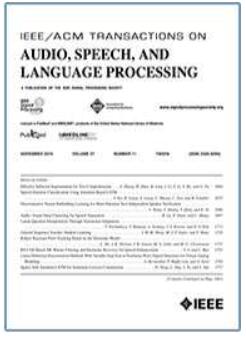助听器中的实时多通道深度语音增强:比较复杂声学场景中的单声道和双声道处理技术
IF 5.1
2区 计算机科学
Q1 ACOUSTICS
IEEE/ACM Transactions on Audio, Speech, and Language Processing
Pub Date : 2024-10-02
DOI:10.1109/TASLP.2024.3473315
引用次数: 0
摘要
深度学习有可能为助听器用户增强语音信号并提高其清晰度。适合实际应用的深度模型应具有计算复杂度低、处理延迟小(仅几毫秒)的特点。在本文中,我们探讨了符合这些要求的深度语音增强技术,并对比了两种复杂声学场景中的单耳和双耳处理算法。这两种算法都通过客观指标进行了评估,并在听力受损的听者进行噪声语音测试的实验中进行了评估。结果与两种传统增强策略(即自适应差分麦克风处理和双耳波束成形)进行了比较。虽然在弥散噪声中,所有算法的表现相似,但双耳深度学习方法在存在空间干扰时表现最佳。通过后期分析,这可以归因于在低信噪比时的改进和精确的空间过滤。本文章由计算机程序翻译,如有差异,请以英文原文为准。
Real-Time Multichannel Deep Speech Enhancement in Hearing Aids: Comparing Monaural and Binaural Processing in Complex Acoustic Scenarios
Deep learning has the potential to enhance speech signals and increase their intelligibility for users of hearing aids. Deep models suited for real-world application should feature a low computational complexity and low processing delay of only a few milliseconds. In this paper, we explore deep speech enhancement that matches these requirements and contrast monaural and binaural processing algorithms in two complex acoustic scenes. Both algorithms are evaluated with objective metrics and in experiments with hearing-impaired listeners performing a speech-in-noise test. Results are compared to two traditional enhancement strategies, i.e., adaptive differential microphone processing and binaural beamforming. While in diffuse noise, all algorithms perform similarly, the binaural deep learning approach performs best in the presence of spatial interferers. Through a post-analysis, this can be attributed to improvements at low SNRs and to precise spatial filtering.
求助全文
通过发布文献求助,成功后即可免费获取论文全文。
去求助
来源期刊

IEEE/ACM Transactions on Audio, Speech, and Language Processing
ACOUSTICS-ENGINEERING, ELECTRICAL & ELECTRONIC
CiteScore
11.30
自引率
11.10%
发文量
217
期刊介绍:
The IEEE/ACM Transactions on Audio, Speech, and Language Processing covers audio, speech and language processing and the sciences that support them. In audio processing: transducers, room acoustics, active sound control, human audition, analysis/synthesis/coding of music, and consumer audio. In speech processing: areas such as speech analysis, synthesis, coding, speech and speaker recognition, speech production and perception, and speech enhancement. In language processing: speech and text analysis, understanding, generation, dialog management, translation, summarization, question answering and document indexing and retrieval, as well as general language modeling.
 求助内容:
求助内容: 应助结果提醒方式:
应助结果提醒方式:


